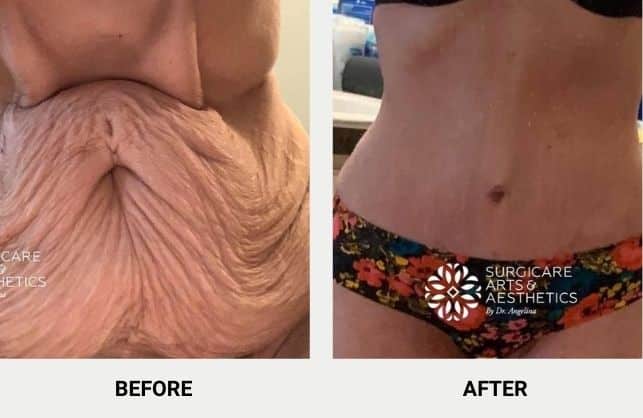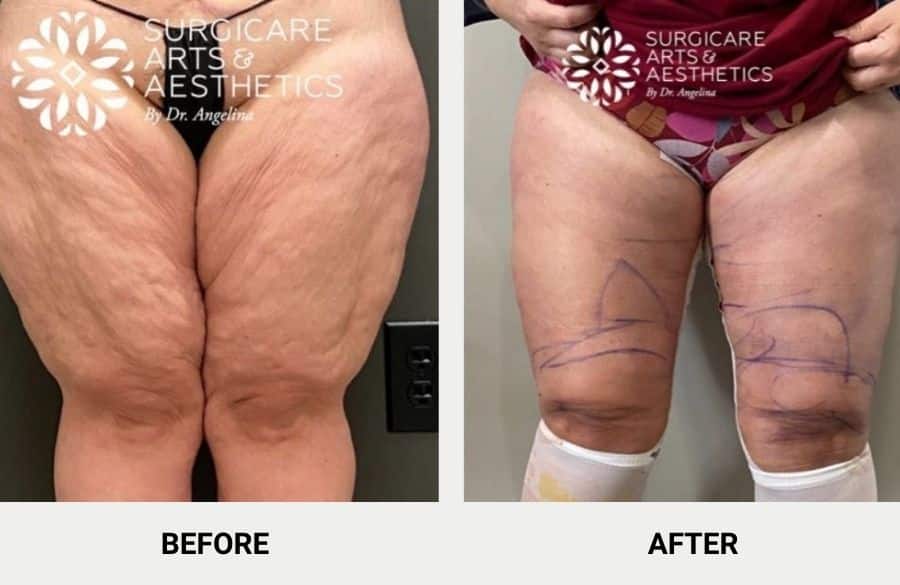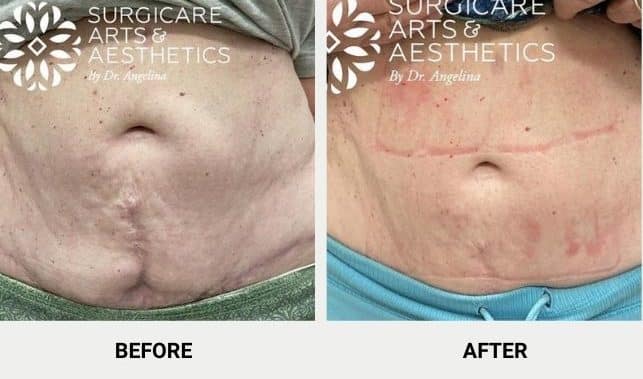Embarking on weight loss surgery offers a mix of emotions for patients. While they anticipate the health benefits, they also envision a more appealing physique. Unfortunately, the unforeseen challenge of loose skin after shedding pounds dampens their excitement. Consequently, these individuals may feel they’ve traded one problem for another. Thankfully, the good news is that loose skin following weight loss surgery can be effectively addressed.
Many patients require skin removal surgery after weight loss The amount and type of loose skin surgery after weight loss will vary depending on how much there is and where it is located. Some patients only need surgery in a few areas to address their issues, while others require a combination of different surgeries to remove excess skin after weight loss.
What Causes Excess Skin after Weight Loss Surgery?
When an individual gains weight, it normally happens progressively and the skin gradually stretches out to accommodate the extra weight. Stretch marks are a common occurrence for many individuals as the skin stretches beyond its normal capacity. Weight-loss surgery works by limiting the number of calories and nutrients the patient’s body can consume.
This results in a very quick and significant loss in excess fat which is located directly under the skin. The skin no longer has anything to support and has lost elasticity, and the ability to shrink back, so it becomes loose and saggy.
How Much Loose Skin Will I Have After Weight Loss Surgery?
It is hard to know exactly how much loose skin an individual will end up with after surgery. Each patient is different and so are the factors that affect them. Genetics, age, height, smoking, the patient’s weight before surgery, and how much weight they lose are all factors that play a part in the development of loose skin.
A general guideline would be, that the more weight you lose, the more likely you are to be left with loose skin. Loose skin can cause physical complications and can also make some patients self-conscious. Understanding that loose skin is a naturally occurring consequence of losing a significant amount of weight, and having a plan ahead of time, will help patients experience a smoother recovery and future.
What Problems Can Loose Skin after Weight Loss Cause?
If patients do not address excess loose skin, it can lead to several problems.
Infection
Excess skin often falls in folds that make it harder to keep clean. They also can trap moisture which creates the perfect environment for bacteria and infection.
Chafing
Loose skin folds can rub against each other and over time can cause a rash or chafing. Many people who end up with loose skin from weight-loss surgery say that chafing stings and burns. It can also cause bleeding, swelling, or scabbing of the skin. Chafing often happens under the arms, stomach, thighs, and groin but anywhere there is loose skin is a potential trouble spot.
Appearance
Moreover, most patients feel uncomfortable about the appearance of their loose skin. They have successfully undergone surgery or weight loss procedures and made permanent lifestyle changes in their diet and exercise routine. However, despite feeling physically great, they are discouraged by the excess skin.
Excess skin is not only aesthetically displeasing but also problematic. Seemingly simple things like trying to zip yourself into a smaller pair of jeans can become an issue. A significant pouch of excess skin hanging down in the stomach area can make it difficult to wear the correct size pants.
For a man having excess loose skin in the breasts can affect the way a shirt looks or fits. One weight loss patient said, that when she saw her reflection while standing in front of a mirror, the person staring back at her didn’t match the way she felt.
Physical
Losing weight and maintaining the weight loss will involve not only a healthy diet but also a good deal of physical exercise. Loose skin can inhibit the ability of a weight loss patient to exercise or possibly embarrass them in a group-type fitness situation such as a gym or aerobics class. Loose skin will bounce up and down, jiggle, cause chafing, etc. while running, jump roping, or performing many other cardio-type exercises.
One tip that will help during your weight loss transformation is to use compression-type garments during your workouts. No matter what activity you are doing, wearing a compression-type garment will help keep loose skin from impeding your workout, prevent chafing, and alleviate any embarrassment or discomfort due to jiggling loose skin.
You will not need the strength of a compression garment worn after a surgical procedure but a tight-fitting athletic shirt or leggings that wick sweat should work. Choose a size smaller than you are so the garment will hold loose skin in place. As you continue to lose weight you can adjust the sizing of the garments you wear.
What Can Be Done About Loose Skin after Bariatric Surgery?
After losing a significant amount of weight, many areas of the body may end up with excess skin. The collagen and elastin in the skin are not able to retract enough to keep up with the amount of weight lost. Patients may end up with excess skin on the arms, abdomen/stomach, thighs, breast area, back, etc.
Successfully achieving the elimination of loose skin after a significant weight loss is essential, regardless of whether the patient’s motivations are aesthetic or physical. Furthermore, undertaking such a procedure will undeniably make a significant difference in helping the patient maintain their weight loss. Depending on the severity of the loose skin, there are both surgical and non-surgical options available to treat it.
Surgery to Eliminate Loose Skin after Weight Loss Surgery
The amount and type of surgery to eliminate loose skin will vary depending on how much it is and where it is located. Some patients only need surgery in a few areas to address their issues, while others require a combination of different surgeries.
Tummy Tuck (Abdominoplasty)
During a tummy tuck, the surgeon removes loose skin and repairs stretched or separated muscles in the stomach/abdomen. This surgery can eliminate excess skin on the entire abdomen and repair separation damage in abdominal muscles. The surgeon may also relocate the belly button if necessary to achieve natural-looking results.

Panniculectomy
Pannus, the excess skin below the naval, can be eliminated to improve appearance. Post-weight loss surgery, removing this loose skin enhances skin comfort, reduces bouncing during exercise, and improves clothing fit. Note that a panniculectomy solely addresses excess skin, unlike a traditional tummy tuck which tightens abdominal muscles.
Arm Lift and Back/Bra Line Lift
Both arm lift and bra line lifts will address loose skin and any excess fat on the upper arm and along the upper back. Often paired with liposuction it will not only eliminate loose skin but create a firmer more contoured appearance.
Breast Lift or Breast Implants
Many female patients experience deflated breasts after losing a significant amount of weight. A breast lift can remove excess skin and may restore contour and symmetry. Breast implants are capable of restoring lost volume, but they do not create or replace any volume that may have been lost.
Men also experience sagging breasts after losing a large amount of weight. This excess skin can be removed through gynecomastia surgery which flattens and enhances the chest contours. Male breast reduction surgery often involves surgically repairing the size or position of the areola.
Thigh Lift and Butt Lift (Lower Body Lift)
Lower body lift surgery can help improve appearance and eliminate chafing by removing excess skin in the thigh or buttock area after weight loss surgery. This procedure also ensures a better fit for clothing.

Non-Surgical Treatments for Loose Skin After Weight Loss
Weight loss patients now have numerous solutions to address loose skin after significant weight loss. Mild cases can be treated with skin tightening treatments.
Loose Skin After Weight Loss: Medical Spa Skin Tightening Treatments
Microneedling, radiofrequency, or a combination treatment like Morpheus8 effectively tightens the skin. Some available treatments include BodyTite, Evolve body contouring treatments specifically Evolve Tone, and PHYSIQ.

Lifestyle Alterations
Living a healthy lifestyle that includes eating a healthy diet and is full of exercise and physical activity can help tone and firm skin. Eating a diet rich in nutrient-packed foods will help replenish the skin’s natural collagen and elastin. Activities such as weight training will increase muscle mass and help alleviate small amounts of loose skin.
Consult With a Cosmetic Surgeon before Weight Loss Surgery
Excess skin post-weight loss surgery can be unwanted. Consulting both a bariatric and cosmetic surgeon beforehand is wise. Prepare for loose skin and other complications to ensure a smooth wellness journey.
SurgiCare Arts is a division of the IBI Healthcare Institute offering continued support as patients navigate weight loss. Dr. Angelina Poestoev, a triple-board certified cosmetic surgeon performs both surgical and non-surgical skin reduction and is also among the very few cosmetic surgeons in the country that specialize in thigh lift surgery. To learn more about skin reduction procedures, call and set up a personal consultation today.










